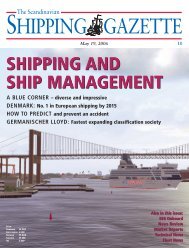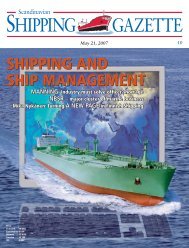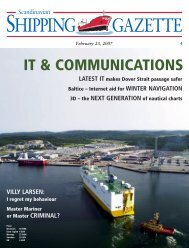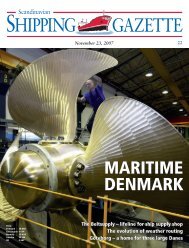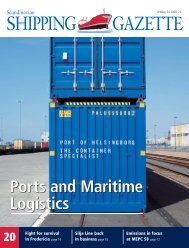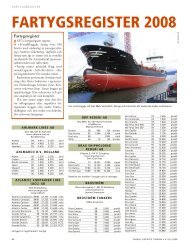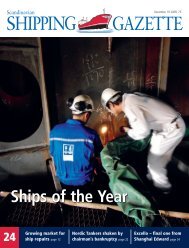SSG No 20 - Shipgaz
SSG No 20 - Shipgaz
SSG No 20 - Shipgaz
You also want an ePaper? Increase the reach of your titles
YUMPU automatically turns print PDFs into web optimized ePapers that Google loves.
The precursors<br />
of the modern bulk carrier<br />
H<br />
aving a deadweight in<br />
excess of <strong>20</strong>,000 tons, the<br />
cargo vessels Amerikaland<br />
and Svealand were the largest<br />
cargo vessels afloat when they were<br />
in 1925 handed over to the Swedish ship<br />
owner Ångfartygs Aktiebolaget Tirfing.<br />
The design featured many new innovations,<br />
and in combination with their<br />
enormous size the vessels were in many<br />
respects forerunners, paving the way for<br />
the pure bulk carrier.<br />
On January 23, 1914, just six months<br />
before the outbreak of World War I, the<br />
Swedish ship owner Dan Broström signed<br />
a contract with the US steel manufacturer<br />
Bethlehem Steel Company on building<br />
two 17,000 DWT steamers. They were to be<br />
employed for <strong>20</strong> years on the iron ore trade<br />
from Cruz Grande, Chile, to the company’s<br />
steel works on the US East coast via the<br />
Panama Canal, which was opened in 1914.<br />
But the war interrupted this interesting<br />
project. It was not until September 1922<br />
that a new contract was signed. <strong>No</strong>w<br />
the size of the two vessels had grown to<br />
<strong>20</strong>,600 DWT, and they were due for delivery<br />
in 1925.<br />
Due to the “advantageous rate of<br />
exchange for Swedish currency and the low<br />
quotations received from the German shipyards”<br />
the vessels were ordered from Deutsche<br />
Werft AG in Germany rather than<br />
from Sweden. The possibility to build the<br />
vessels at Götaverken had been thoroughly<br />
investigated. In addition to a higher price<br />
this would also have demanded an extension<br />
of the shipyard, as the newbuildings<br />
were twice as large as the vessels built so far.<br />
The Svealand was handed over to the<br />
Tirfing Steamship Company on April 9,<br />
1925, and the sister Amerikaland on June<br />
29. The 171 m long and 22 m wide vessels<br />
were exceptional in many aspects, not<br />
least their size. They were the largest cargo<br />
vessels built so far and among the first to<br />
be equipped with steel hatch covers. The<br />
hatchways were large to enable rapid cargo<br />
handling. Two Burmeister & Wain-type<br />
diesel engines manufactured in Germany<br />
gave them a service speed of 11 knots fully<br />
loaded with a fuel consumption of 19.5<br />
tons a day. They were no doubt also exceptionally<br />
efficient. A voyage from Chile to<br />
Baltimore could be made in 19 days and<br />
the vessels could be discharged in 16 to 18<br />
hours.<br />
For the Amerikaland World War II<br />
HÅKAN SJÖSTRÖM<br />
ended the fulfilment of the <strong>20</strong>-year charter.<br />
During a ballast voyage from Sparrows<br />
Point to Cruz Crande she was sunk by<br />
the German u-boat U 106 on February<br />
2, 1942. Five seamen lost their lives after<br />
spending several days in lifeboats on the<br />
cold and stormy sea.<br />
For the Svealand the charter to Bethlehem<br />
Steel continued until the end of<br />
1948. In 1951 she underwent an extensive<br />
refit at Götaverken in Göteborg, including<br />
installation of new main engines.<br />
The Svealand continued sailing for Broströms<br />
until 1968, when the 43-year-old<br />
vessel was sold to a company in Liberia.<br />
The deal was never closed and instead the<br />
German company Eckhardt & Co bought<br />
her in 1969 for scrap. In the same year<br />
she was sold further to a Panama-registered<br />
company and left Hamburg under<br />
her own power renamed Svea. After that<br />
her fate is unknown, even though it was<br />
reported that she would be broken up.<br />
In a fleet list in the Båtologen magazine<br />
Tomas Johannesson writes that it is not<br />
impossible that she continued sailing in<br />
the Chinese waters or was used as a floating<br />
storage for some further years.<br />
pär-henrik sjöström<br />
86 SCANDINAVIAN SHIPPING GAZETTE • OCTOBER 26, <strong>20</strong>07




